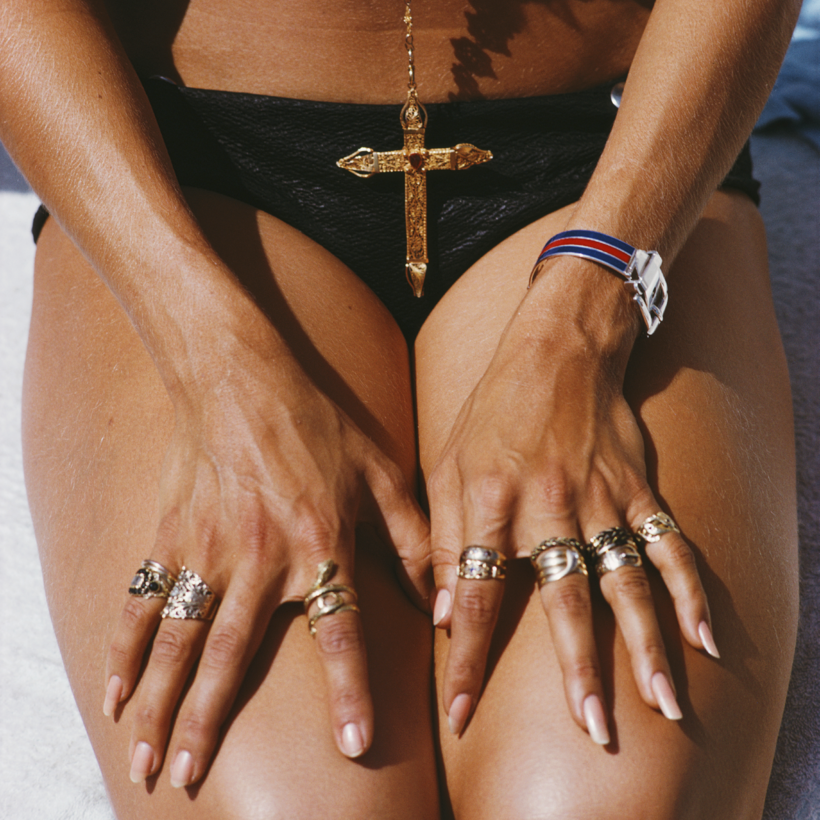You probably remember the commercial. You definitely remember the jingle; it has a Banquo-like ability to pop into your head at random moments: “Bain de Soleil for the St. Tropez tan …” The supple brilliance of Bain de Soleil—the beloved French sunscreen that was only partly French and never a sunscreen—was its ability to harness the power of suggestion for a smoother, newer, more sophisticated self.
Developed in 1925 by Monsieur Antoine of Paris, a hairdresser whose clients included Coco Chanel, Greta Garbo, and Sarah Bernhardt, the silky orange gel sought to capitalize on the new French penchant for tanned skin—a trend inspired by Chanel’s post-vacation glow. At the time, France was the sun around which the entire fashion world revolved, so when Antoine Bain de Soleil (“bain de soleil” means “sunbath”) hit the U.S., in the 1940s, it was already a hot property.
Encouraged by skyrocketing sales, the American market did what the American market does best: it bought and sold the brand numerous times to different beauty and pharmaceutical giants, including Procter & Gamble, Pfizer, and Bayer. The bumpy corporate ride didn’t damage the product’s appeal. If anything, demand soared. Each subsequent owner expanded the Bain de Soleil umbrella to include new offerings, and, eventually, the name Antoine was excised and Orange Gelée stood for the brand.
By the 1980s, the products seemed to exude a Continental élan—an illusion nurtured by that catchy and seductive ad campaign with its slow, hypnotic tune. It’s ironic when you consider the commercial ran while Bain de Soleil belonged to the same Connecticut-based company that gave us Vicks VapoRub—far away from the Côte d’Azur lifestyle.

Even more out of sync with its jet-set image was the formula itself. “The base is cheap, and the ingredients are terrible,” says Ginger King, a cosmetic chemist and brand consultant. “Most of them are known comedogens that clog pores.” While nothing can unravel a sexy narrative like a case of acne, there was a more serious concern. Marketed as a sunscreen, the original gelée offered a scanty S.P.F. 4— the sunblock equivalent of a micro-bikini. (For context, dermatologists today recommend wearing S.P.F. 30 even on cloudy days.) Although the commercial suavely boasts that Bain de Soleil is “for people who can choose anything they want,” they probably don’t want irreparable sun damage.
That said, there’s something fascinating about the brand’s casual disregard for facts. It seems to hover above them on a silver platter. (A waiter in a tuxedo actually presents the lotion on a silver tray in the 1983 commercial.) But the formula has its tangible merits too. Packaged in a metallic tube, the distinctive orange gel resembles an oil paint, as if Cézanne might have squeezed it onto a palette to capture the Provençal light. Then there’s the texture: a wobbly, moisture-rich emulsion that glides over skin and renders it baby-dolphin smooth.
But the real pièce de résistance is the scent. That scent—a mix of white flowers and coconut oil that’s as redolent of summer as ripe tomatoes and wet Lycra. One whiff and you’re a kid listening for the siren call of an ice-cream truck again. In fact, the scent weaves such a potent spell of nostalgia that both Tom Ford and Michael Kors (a Bain de Soleil devotee) have produced fragrances that conjure the tropical, sunscreen-y smell.
Such intense emotional attachments help to explain why things got so heated in December 2019 when Bayer announced its decision to retire the brand and cease production of all Bain de Soleil products. Backlash was swift; tempers flared. There was a run on inventory that left gaping black holes on pharmacy shelves. A resident of Staten Island, New York, launched a petition on Change.org in a futile attempt to muscle his beloved Orange Gelée back into production. (To date, the plea has amassed nearly 10,000 signatures.)
And a search for the stuff on third-party retail sites such as eBay and Mercari demonstrates the economic concept of scarcity. At last check, one tube of Orange Gelée SPF 4 sold for $500 on Poshmark.
That scent—a mix of white flowers and coconut oil that’s as redolent of summer as ripe tomatoes and wet Lycra.
These tales don’t exactly align with the “limited consumer interest” that Bayer cites as its reason for discontinuing the brand. (Bayer did not respond to Air Mail’s requests for comment.) The likelier scenario? Bain de Soleil couldn’t hack it in the Information Age. It’s impossible to ignore the grave warnings about skin cancer that dermatologists have brought to every sun-related discussion. Our preferences have shifted dramatically, too. The most popular beauty products today borrow technology from scientifically legitimate sources, including cellular biologists and aerospace engineers. (Cosmetics companies just might employ as many rocket scientists as NASA.). There’s no room in a transparent, data-driven world for a formula that promotes colorful myths and risky fantasies. It might not be pretty, but the truth can sometimes save us from getting burned.
That time in the sun sure was golden, though.
Liana Schaffner is a Massachusetts-based writer who frequently contributes to Allure, Harper’s Bazaar, and Town & Country





